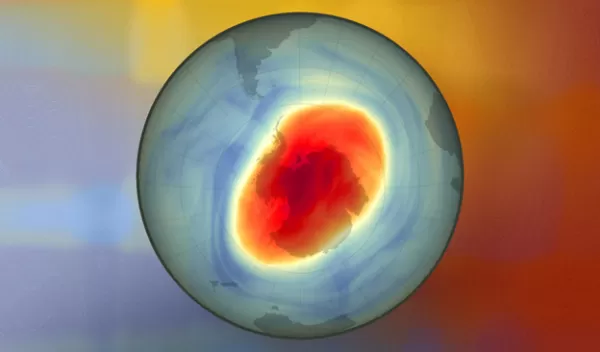
Smoke particles from wildfires can erode the ozone layer
A wildfire can pump smoke up into the stratosphere, where the particles drift for over a year. A new Massachusetts Institute of Technology study has found that while suspended these particles can trigger chemical reactions that erode the protective ozone layer shielding the Earth from the sun's damaging ultraviolet radiation.
The study, published in Nature, focuses on the smoke from the "Black Summer" megafire in eastern Australia, which burned from December 2019 into January 2020. The fires — the country's most devastating on record — scorched tens of millions of acres and pumped more than 1 million tons of smoke into the atmosphere.
The U.S. National Science Foundation-supported team identified a new chemical reaction by which smoke particles from the Australian wildfires made ozone depletion worse. By triggering this reaction, the fires likely contributed to a 3%-5% depletion of total ozone at mid-latitudes in the Southern Hemisphere in regions overlying Australia, New Zealand and parts of Africa and South America.
The researchers' model also indicates the fires had an effect in the polar regions, eating away at the edges of the ozone hole over Antarctica. By late 2020, smoke particles from the Australian wildfires widened the Antarctic ozone hole by 2.5 million square kilometers — 10% of its area compared to the previous year.
It's unclear what long-term effect wildfires will have on ozone recovery. The United Nations recently reported that the ozone hole, and ozone depletion around the world, is on a recovery track, thanks to a sustained international effort to phase out ozone-depleting chemicals. But the study suggests that as long as these chemicals persist in the atmosphere, large fires could spark a reaction that temporarily depletes ozone.
"The Australian fires of 2020 were really a wake-up call for the science community," says climate scientist Susan Solomon of MIT. "The effect of wildfires was not previously accounted for in [projections of] ozone recovery. And I think that effect may depend on whether fires become more frequent and intense as the planet warms." The study is led by Solomon and MIT researcher Peidong Wang.
The study expands on a 2022 discovery by Solomon and her colleagues, in which they first identified a chemical link between wildfires and ozone depletion. The researchers found that chlorine-containing compounds, originally emitted by factories in the form of chlorofluorocarbons, could react with the surface of fire aerosols.
The interaction, they found, set off a chemical cascade that produced chlorine monoxide — the ultimate ozone-depleting molecule. Their results showed that the Australian wildfires likely depleted ozone through this newly identified chemical reaction.
When the team incorporated this new chemical reaction into a model of atmospheric chemistry and simulated the conditions of the Australian wildfires, they observed a 5% depletion of ozone throughout the stratosphere at mid-latitudes, and a 10% widening of the ozone hole over Antarctica.
"The possible impacts of wildfire aerosols on delaying ozone recovery and promoting ozone loss at even warmer stratospheric temperatures are sobering," says Varavut Limpasuvan, a program director in NSF's Division of Atmospheric and Geospace Sciences. "They raise concerns about the future potential for more frequent and intense wildfires counteracting current measures to phase out ozone-destroying chemicals."
